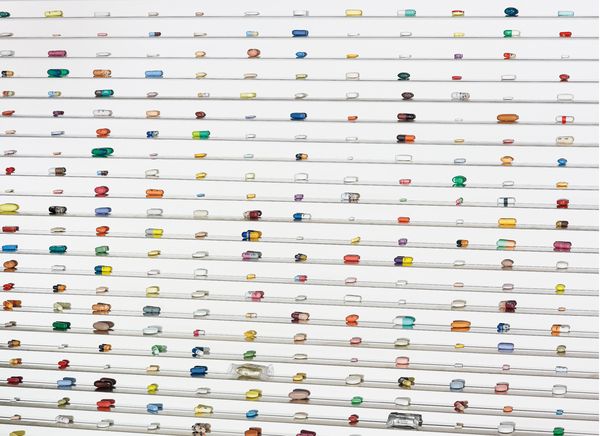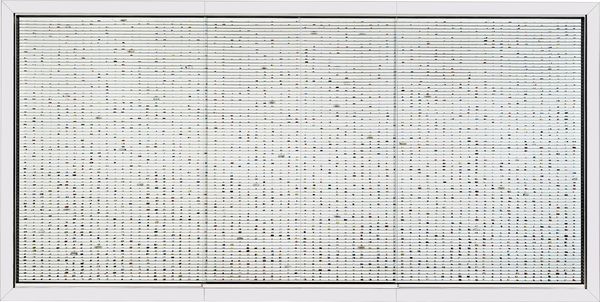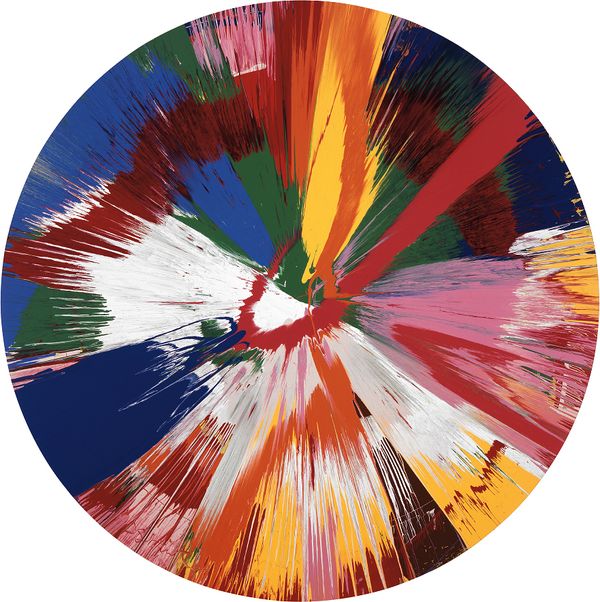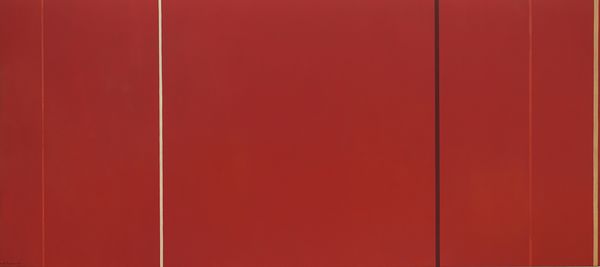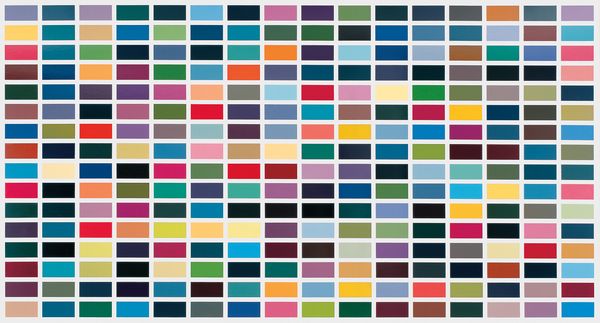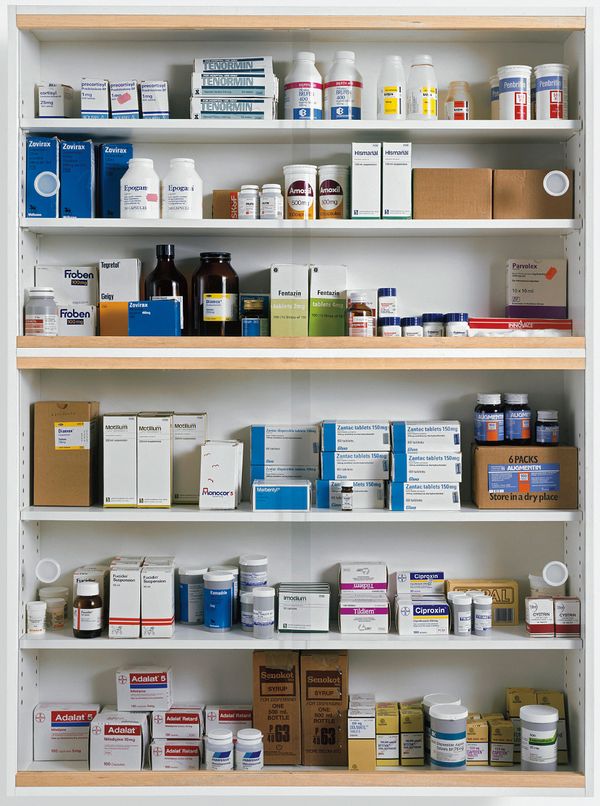Damien Hirst The Void, 2000 (detail)
Damien Hirst's The Void is the largest of his Pill Cabinets ever to come to auction and one of the first he ever made. Within a vast, searching oeuvre, the series of Pill Cabinets make up but a tiny part of the artist's creative universe.
Three of the top seven prices achieved at auction for Hirst's work are for Pill Cabinets, including the current record for the smaller, later example Lullaby Spring. The Void is the first Pill Cabinet the artist showed in a commercial exhibition – his seminal and celebrated Theories, Models, Methods, Approaches, Assumptions, Results and Findings show at the Gagosian Gallery in New York – and it is the first Pill Cabinet he showed in the United States. Other examples can be found in such esteemed Foundations as the Broad Museum or the Pinault Foundation, and in museums such as the Bayerische Staatsgemaldesammlungen – Museum Brandhorst in Munich and the Leeum Museum in Seoul.
I think it's like the best piece I've ever made.
—Damien Hirst
Damien Hirst The Void, 2000. Glass, stainless steel, steel, aluminum, nickel, bismuth and cast resin, colored plaster and painted pills with dry transfers.
The rarity and significance of the Pill Cabinets series, the importance of this example being the first ever exhibited Stateside and the monumental scale and dazzling visual complexity of this example all combine to elevate the prominence of The Void – making it one of, if not the most important work of art by Damien Hirst to come to auction.
Like the other Pill Cabinets, The Void is a deeply-wrought, highly-stylized, pristine object that orbits around many of Hirst's chief artistic concerns: the exploration of the binaries of life and death; the division yet synergy between art and science; the dialectic proposed between the time-consuming laboriousness of his process and fabrication with the presentational immediacy of the aesthetic and intellectual impact achieved when confronting an object like The Void.
Damien Hirst Beautiful, pop, spinning ice creamy, whirling, expanding painting, 1995. Household gloss on canvas. © Damien Hirst and Science Ltd. All rights reserved/DACS, London/Artists Rights Society (ARS), NY 2017, Image courtesy White Cube. Photo: Stephen White
The same formal structure and presentational logic of sliding glass doors, mirrored back and shiny, sterilized, stainless steel casing are enlivened and individualized by the display of hand-made and hand-painted pills lined up with acute, surgical precision along razor sharp shelves. The intricacy of the pills, individually cast in metal, plaster and resin and executed on such a small scale and with such attention to detail and craftsmanship, is at odds with the massive, surgical space that they inhabit.
Litotes and hyperbole here become blood brothers, both working together to engender an almost ethereal artistic experience. As such, when one confronts one of these clinical cabinets, and especially one as large and impressive as The Void, the viewer cannot help but be utterly spellbound by the kaleidoscopic display of waves of complex color assonances and dissonances that the multitude of pills reflect in the sparkling mirror behind. In this sophisticated, seemingly haphazard yet absolutely predetermined matrix of color, patterns begin to emerge which replicate the complexity of those genetic strands that are the building blocks of life.
Barnett Newman Vir Heroicus Sublimis, 1950-1951. Oil on canvas, The Museum of Modern Art, New York. Digital Image © The Museum of Modern Art/ Licensed by SCALA/Art Resource, NY. Artwork © 2017 The Barnett Newman Foundation, New York/Artsits Rights Society (ARS), New York
Hirst's passion for color, articulated in such a monumental, yet restrained, even clinical manner, has several art-historical forebears. Barnett Newman's magnificent Vir Heroicus Sublimis (1950-51, New York, The Museum of Modern Art) revels and delights as a vast horizontal ground of crimson, interrupted only by a handful of minimal, vertical zips of color that offer a moment's respite – spatially, temporally and formally – from the overwhelming experience of such saturated, luxurious color.
Hirst's mirrored background and stainless steel frame serves to bombard the object with its own reflections, thereby saturating what should be empty, negative "space" with steady pulsations of color derived from the multitude of colored pills, not too far removed from the feelings evinced by Newman's masterpiece. It's as if The Void momentarily fragments the viewing experience of the Newman, breaking down its chromatic totality in to a myriad of parts – much like a Spot Painting metaphorically does.
Whereas Hirst lets color go out to play and come home late, Donald Judd insists on color being in bed nice and early.
Donald Judd Untitled, 1991. Clear anodized aluminum and green acrylic sheet.
The elegance of The Void's stainless steel form, displayed on the wall (its exhibition at odds with its physicality) finds numerous connections to the art of Donald Judd. Color, however, also finds a strong nexus between Judd and Hirst. Judd has long been considered a colorist (indeed, The Tate celebrated Judd with an exhibition called Donald Judd – Exploring Colour in 2004). Judd choreographed color in the most refined, economic way. He treated color like he did form; one approached a red or blue or yellow not emotionally, but phenomenologically. Hirst, too, orchestrates color in his perfectly designed rectangular form. However, color creeps up on you in The Void, ever so slowly taking prominence away from form and design. So where Hirst shares Judd's passion for simple, impactful chromatic presentation, voiced through the equally simple language of mathematical form, Hirst is more playful with color and liberates it from the mechanics of design. Hirst lets color go out to play and come home late; Judd insists on color being in bed nice and early.
Gerhard Richter 256 Farben, 1974. Oil on linen, The Doris and Donald Fisher Collection at the San Francisco Museum of Modern Art. Photo credit: Ian Reeves Artwork © Gerhard Richter
Another, and perhaps most telling, comparison would be with Gerhard Richter's wonderful Color Chart paintings, executed at the beginning of the 1970s. Here, content becomes mere squares of color, arranged across the surface of the painting, with no artistic intent other than the completion of their arrangement. At the time these paintings were completely radical (and, when one looks at one today, they have lost none of that radicality). Hirst shares Richter's desire to let color shape the design (and power) of the composed surface. Indeed, he would go on to create his own body of Pantone works, such as Spectrum for Artists (2015), where the similar block of color is employed, but labeled as per the Pantone color Hirst wants to display. But where Richter insists on a flat surface occupied by single blocks of color with no other trajectories of meaning attached to them, Hirst's color is not simply color: it (and its meaning) comes from the pills, so that several trajectories of understanding pool together in The Void to create an estuary of possible readings, many of which stem from the colors Hirst chooses for the work.
The genesis of the Pill Cabinets can be best understood by mapping a quick trajectory of Hirst's own oeuvre in the 1990s. However, his "Eureka" moment came at the very end of that decade, unable to sleep, a house-guest of his gallerist, "It's fifteen by seven feet. It's just an awesome sculpture. But I worked it out, in and out of sleep, lying in bed, unsure, trying to convince myself, not being convinced...But it actually happened at Larry's house, in bed, on my own. I remember waking up like that. Bang!" That "Bang" was not some isolated flash of inspiration but rather the culmination of a decade's worth of ideas slowly percolating into Hirst's creative enterprise. Each prior series opened up the conceptual and plastic opportunities to go ahead and realize a work such as The Void. The result has captivated not only our imagination and attention ever since, but the artist's. "I think it’s like the best piece I’ve ever made," Hirst declared, as quoted in On the Way to Work.
Hirst had experimented with actual pills as far back as the late 1980s with a series of monochrome canvases in which he made tiny incisions to accommodate real pills (he would return to using real pills on canvases in his Remedy Paintings begun in 2008). At the same time Hirst was just beginning to make his Spot Paintings. Each spot of color can be seen as the pixelated DNA of painting itself. Given the titles of these Spot Paintings, purloined from catalogues listing the labels of various pharmaceuticals, the formal construct of each spot of pure color is inextricably linked to the same circular design of tablets or pills.
For Hirst, The Void is that unknown space that human experience hopes to fill with the marvel of Gods, the surety of Science, or the beauty of Art.
Damien Hirst God, 1989. Glass, faced particleboards, ramin, plastic, aluminum and pharmaceutical packaging. © Damien Hirst and Science Ltd. All rights reserved/DACS, London/Artists Rights Society
Another early and significant body of work that begins the journey from the late 1980s to the fabrication of the first ever Pill Cabinets at the end of the 1990s is the Medicine Cabinets. The Medicine Cabinets presented rows of empty pharmaceutical packaging, arranged simply but displayed in relatively rudimentary cabinets made of glass and MDF. The brand, shape, size and color of the appropriated boxes, and Hirst's deliberate presentation of them initiated the dialogue between art and science; between creativity and medicine; between the "Formal" of design and the Informel of "color" and "expression."
Perhaps, more than anything, the Pill Cabinets explore Hirst's constant embrace of the antagonism between fiction and reality and of all the discombobulating slippages of signification that binary contains. As Hirst has said, "They look like real pills; that's all that matters. Real pills decay. They rot. They're made to dissolve in your body. Plus they're full of toxic substances. It's impossible to get them...art's not real life. I'm into theatre. I'm totally not into 'truth to materials'. As long as you can convince people...it doesn't matter whether it's real or not. Because the whole dilemma is: Is it real or isn't it? It's like: Are you real? What the fuck's going on?"
The Void is like a giant altarpiece to modern medicine. It embodies and powerfully displays the essentials – the logic, lexis and praxis – of Damien Hirst's whole oeuvre by interrogating the common ground between the antithetical faculties and diametric opposites of science and art. Fascinated by the life sciences – pharmacology in particular – many of Hirst's breakthrough works from the Medicine Cabinets to the Spot Paintings leverage the authority and credibility of science to shock the viewer into directly confronting the fundamentals of existence: the hair's breadth between life and death and the nanosecond of experience we all contribute to the timeline of history.
The Void is an astonishing work of art by one of today's most provocative, intelligent and ambitious artists. It is, in many ways, a classic fin-de-siècle masterpiece that looks back at the previous century yet clearly sets the tone for Hirst's own artistic production (and that of others too) moving into the 21st Century.
For Hirst, The Void is that unknown space that human experience hopes to fill with the marvel of Gods, the surety of Science, or the beauty of Art. But it is also a challenge, a challenge specific to Hirst himself as an artist – how, as an artist, to fill this void.
